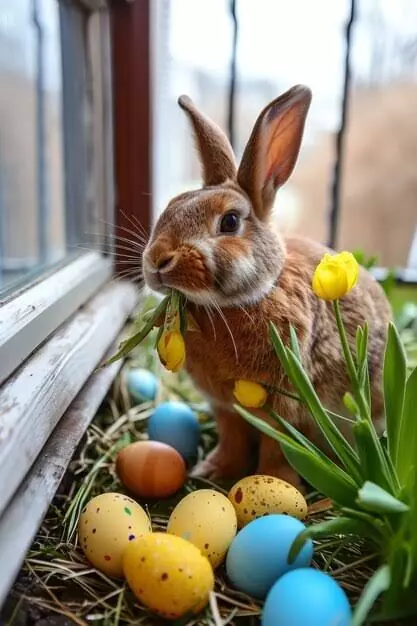From myth to mascot: The story of Easter Bunny
Thus, the egg-laying hare was born—not as a symbol of innocence, but of sacred transformation
By Anoushka Caroline Williams
Representational Image.
Hyderabad: When you think of Easter, you likely imagine pastel-colored eggs, baskets brimming with candy, and, of course, the Easter Bunny.
Fluffy, innocent, and hopping with joy, the bunny has become the cheerful face of the holiday. But behind the sugary smiles and cartoonish ears lies a far older and more complex tale. One steeped in ancient myth, pagan fertility rites, and cultural evolution. This is the Easter Bunny as you’ve never seen it before.
The Pagan Roots: More Than Fluff and Whiskers
Long before Christianity laid claim to Easter, early European cultures celebrated the arrival of spring with rites that honored renewal, fertility, and life cycles. Central to many of these celebrations was a goddess named Ēostre (or Ostara), a Germanic deity of dawn and rebirth.
Legend has it that Ēostre once found a bird whose wings had frozen in the snow. Out of compassion, she transformed it into a hare so it could survive the winter. Yet, in a nod to its avian origins, the creature retained its ability to lay eggs, once a year, on the day of celebration in Ēostre’s honor. Thus, the egg-laying hare was born—not as a symbol of innocence, but of sacred transformation.
From Myth to Mascot: How the Bunny Was Tamed
The transition from pagan goddess worship to Christian tradition was neither clean nor complete. As Christianity spread across Europe, many pagan customs were adapted rather than eradicated. The feast of Ēostre was conveniently merged with the Christian celebration of Christ’s resurrection. And the hare—already steeped in ancient fertility symbolism—was quietly repurposed into something more palatable for the new religious narrative.
German immigrants brought the “Osterhase” (Easter hare) to America in the 1700s. According to folklore, this mythical rabbit would lay colorful eggs for well-behaved children. Over time, the Osterhase evolved into the Easter Bunny we recognize today, complete with candy, toys, and corporate endorsements. Yet even as the bunny became softer and sweeter, its roots remained firmly tangled in a far more mystical soil.
Symbols of Duality: Life, Death, and the Cycle Between
What many overlook is the hare’s longstanding symbolism not just of life, but also of death and resurrection—a perfect fit for both pagan spring festivals and Christian Easter.
In ancient Celtic and Norse traditions, hares were believed to be shape-shifters—creatures that moved between worlds, symbols of liminality and transformation. In some myths, they were companions to witches, eyes glowing in the dark, messengers of the spirit world. In others, they were sacrificed in spring rites, their blood nourishing the land to ensure fertility and abundance.
The image of a bunny hiding eggs—symbols of new life—takes on an eerie resonance when we consider the deeper allegory: the hidden mysteries of life and death, buried and resurrected with the turning of the seasons.
Commercial Resurrection: How the Bunny Became Big Business
By the 20th century, the Easter Bunny had been fully commercialized. Chocolate rabbits lined store shelves, mass-produced egg hunts became marketing spectacles, and the sacred rite of spring was replaced with a Hallmark-sponsored sugar rush.
But in this transformation lies a subtle kind of erasure. The Easter Bunny we celebrate today is a sanitized ghost of its former self, devoid of its pagan grit, its mythic weight, its association with feminine divinity, lunar cycles, and the rawness of rebirth.
The dark side of the bunny isn’t about evil. It’s about depth. It’s about honoring the shadows beneath the pastel surface—remembering that rebirth only comes after death, and that innocence is most powerful when it knows what it’s survived.
Hiding in Plain Sight: The Return of the Mythic Hare
In recent years, there’s been a quiet resurgence of interest in the Easter Bunny’s deeper symbolism. Modern pagans and spiritual seekers are reclaiming the hare as a sacred totem—of mystery, of moonlight, of the feminine wild. Artists and writers are unearthing the darker myths, peeling back the commercial gloss to reveal the archetype underneath.
Because the truth is, the Easter Bunny isn’t just cute. It’s ancient. It’s powerful. It’s a creature of the in-between—living in that liminal space where winter gives way to spring, where death yields to life, where gods rise and legends whisper in the tall grass.
So the next time you spot that chocolate bunny, stop and consider what it represents. Not just sweetness, but survival. Not just candy, but transformation. Not just a rabbit—but a reminder that every light has its shadow, and every beginning comes from something buried, broken, and reborn.